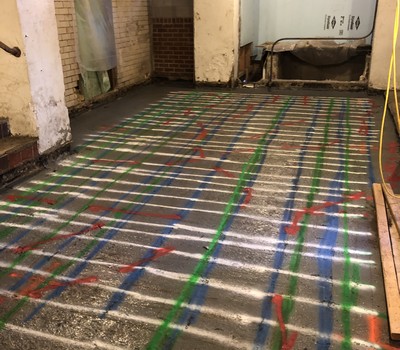Beyond the Surface: Leveraging Advanced Concrete Scanning Techniques for Unmatched Precision and Understanding
Advanced concrete scanning techniques have arised as essential tools in this pursuit, using a glance below the surface area to introduce a world of crucial understandings. By harnessing innovative innovations, experts can reveal abnormalities, evaluate the problem of concrete structures, and make notified decisions that form the course of projects.
Value of Advanced Concrete Scanning
The significance of utilizing innovative concrete scanning techniques hinges on the unmatched accuracy they use for spotting sub-surface abnormalities and making sure architectural integrity. By employing sophisticated innovations such as ground-penetrating radar (GPR), electromagnetic induction, and advanced sonar imaging, building experts can dive under the surface area of concrete frameworks with a degree of accuracy that far exceeds typical examination approaches. Concrete Scanning. These strategies enable the identification of hidden risks like rebar corrosion, voids, conduits, or post-tension cable televisions that might compromise the security and safety and security of a framework gradually
In addition, progressed concrete scanning supplies important understandings right into the general problem of a concrete component without the requirement for invasive measures, reducing the risk of causing damage throughout the evaluation process. The capacity to pinpoint the exact location and deepness of possible problems permits targeted fixings and upkeep, inevitably extending the life expectancy of the structure and optimizing its efficiency. Basically, the relevance of sophisticated concrete scanning can not be overemphasized in the realm of building and construction and framework maintenance, where precision and integrity are vital.
Kinds Of Cutting-Edge Technologies

Abnormalities and Flaw Detection

In enhancement to GPR, concrete scanning strategies like thermography and impact-echo screening are likewise efficient in identifying problems and anomalies. By leveraging these innovative strategies, specialists can proactively attend to structural issues, ensuring the long life and safety and security of concrete frameworks.
Assessing Concrete Condition
Exactly how can designers precisely examine the condition of concrete frameworks to ensure their longevity and safety and security? Evaluating the concrete condition is a vital element of maintaining facilities honesty. Different advanced concrete scanning strategies are utilized for this purpose. Ground-penetrating radar (GPR) is generally utilized to analyze the interior structure of concrete, identifying gaps, splits, and other abnormalities that may compromise its toughness. Furthermore, impact-echo testing can give insights into the density and stability of concrete components. Ultrasonic pulse speed screening is another beneficial method for reviewing concrete high quality by gauging the speed of acoustic waves through the material.
Moreover, visual inspection remains an essential component of concrete problem evaluation. Engineers visually check out the surface for indications of deterioration, such as spalling, breaking, or discoloration. Integrating non-destructive screening approaches with visual examinations enables for an extensive assessment of concrete condition, making it possible for designers to determine potential concerns at an early stage and apply prompt upkeep or fixings. By leveraging these advanced strategies, designers can make sure the lasting resilience and check out here safety and security of concrete frameworks.
Enhancing Decision-Making Processes
In the realm of infrastructure administration, optimizing decision-making procedures is vital for ensuring the reliable maintenance and longevity of concrete frameworks. Enhanced decision-making processes in concrete monitoring include utilizing advanced scanning strategies to gather detailed information on the problem of structures. By leveraging technologies such as ground-penetrating radar and 3D imaging, stakeholders can make enlightened decisions concerning repair, support, or replacement methods.
These advanced scanning methods offer very useful insights right into the internal structure of concrete, recognizing possible problems such as gaps, splits, or corrosion that may not be noticeable on the surface. This degree of in-depth details enables positive upkeep planning, decreasing the risk of structural failings and boosting the total life expectancy of concrete structures.
Moreover, by incorporating digital documentation and evaluation devices right into the decision-making procedure, stakeholders can track the advancement of concrete problems in time, making it possible for try this anticipating upkeep strategies and enhancing resource allowance. Eventually, the assimilation of advanced concrete scanning techniques enhances decision-making processes by supplying unrivaled accuracy, understanding, and performance in facilities management.
Conclusion
Finally, progressed concrete scanning methods provide exceptional accuracy and insight in spotting anomalies, issues, and analyzing the condition of concrete structures. By leveraging sophisticated modern technologies, decision-making procedures can be enhanced, leading to even more educated and effective remedies for preserving and repairing concrete framework. These techniques play an essential function in guaranteeing the security and long life of concrete structures, making them an important tool in the field of construction and engineering.
Additionally, advanced concrete scanning provides invaluable insights right into the overall condition of a concrete aspect without the need for intrusive procedures, reducing the threat of triggering damages throughout the evaluation process - Concrete Scanning. One more innovative technology is 3D X-ray scanning, which supplies detailed images of the inner framework of concrete, offering beneficial details without the requirement for destructive testing. In Addition, Concrete Cover Meters are made use of to determine the thickness of concrete cover over support bars properly. Enhanced decision-making processes in concrete management entail utilizing sophisticated scanning strategies to gather in-depth data on the condition of structures.In verdict, progressed concrete scanning methods supply unmatched accuracy and insight in finding abnormalities, issues, and evaluating the condition of concrete frameworks